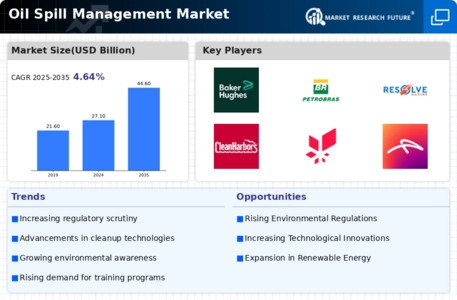Investment in Research and Development
The Oil Spill Management Market is benefiting from increased investment in research and development (R&D) aimed at improving spill response technologies. Companies and governments are recognizing the importance of developing innovative solutions to address the challenges posed by oil spills. This investment is leading to the creation of new materials and methods for spill containment and cleanup, such as bioremediation techniques and advanced absorbent materials. The R&D efforts are not only focused on enhancing existing technologies but also on exploring novel approaches to spill management. As a result, the market is expected to see a rise in the availability of effective and efficient spill response solutions. The commitment to R&D is likely to play a crucial role in shaping the future landscape of the oil spill management sector.
Increasing Regulatory Compliance Requirements
The Oil Spill Management Market is heavily influenced by stringent regulatory compliance requirements imposed by various governmental bodies. These regulations mandate that companies operating in oil and gas sectors implement effective spill response plans and maintain preparedness for potential incidents. The International Maritime Organization (IMO) and the Environmental Protection Agency (EPA) have established guidelines that necessitate regular training and equipment upgrades. As a result, organizations are compelled to invest in advanced spill management technologies and training programs to comply with these regulations. This trend is expected to drive market growth, as companies allocate resources to ensure compliance and mitigate the risk of penalties. The increasing focus on regulatory adherence is likely to shape the future landscape of the oil spill management sector.
Technological Innovations in Oil Spill Management
The Oil Spill Management Market is experiencing a surge in technological innovations that enhance spill response capabilities. Advanced technologies such as drones, remote sensing, and artificial intelligence are being integrated into spill management strategies. These innovations allow for real-time monitoring and assessment of spill incidents, significantly improving response times. For instance, the use of unmanned aerial vehicles (UAVs) has been shown to increase the efficiency of spill detection and mapping. Furthermore, the market for oil spill response equipment is projected to reach USD 2.5 billion by 2026, driven by these technological advancements. As companies adopt these cutting-edge solutions, the overall effectiveness of oil spill management is likely to improve, thereby reducing environmental impact and associated costs.
Rising Incidence of Oil Spills and Environmental Disasters
The Oil Spill Management Market is significantly impacted by the rising incidence of oil spills and environmental disasters. Recent statistics indicate that oil spills have increased in frequency due to factors such as aging infrastructure and increased maritime traffic. This trend has heightened the need for effective spill management solutions, as the environmental and economic repercussions of spills can be devastating. The market is responding to this challenge by developing more robust spill response strategies and technologies. For instance, the demand for containment booms and skimmers has surged, as companies seek to enhance their preparedness for potential incidents. The increasing awareness of the consequences of oil spills is likely to drive investments in spill management, thereby shaping the future of the industry.
Growing Environmental Awareness and Corporate Responsibility
The Oil Spill Management Market is witnessing a heightened emphasis on environmental awareness and corporate responsibility. Stakeholders, including consumers and investors, are increasingly demanding that companies adopt sustainable practices and demonstrate accountability in their operations. This shift in public perception is prompting organizations to prioritize oil spill management as part of their corporate social responsibility (CSR) initiatives. Companies are investing in spill prevention technologies and response strategies to minimize environmental damage and enhance their reputations. The market for oil spill management solutions is projected to grow at a compound annual growth rate (CAGR) of 5.2% through 2028, reflecting this growing commitment to sustainability. As businesses align their operations with environmental stewardship, the oil spill management sector is likely to evolve, fostering innovation and improved practices.


















Leave a Comment